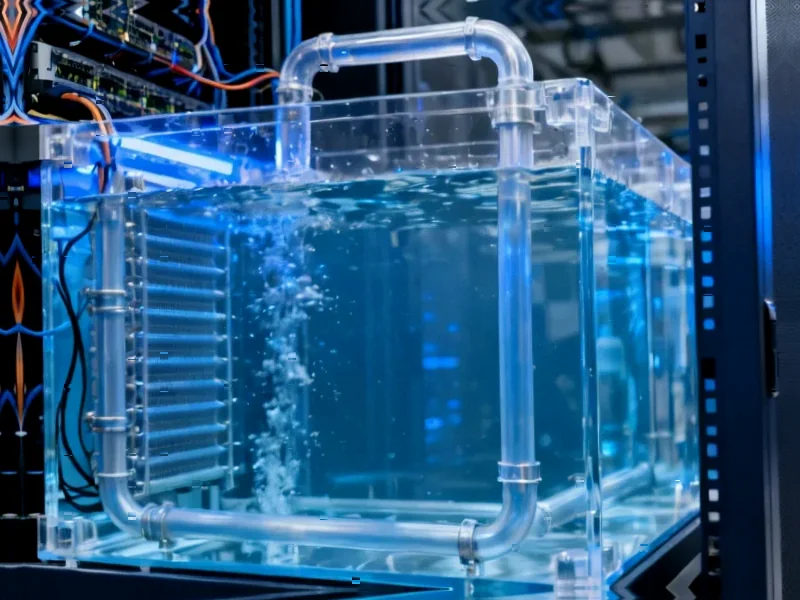According to CRN, Cisco has launched its Unified Edge platform at Cisco Partner Summit 2025, positioning it as an integrated compute platform that extends data center power to network edges for real-time AI applications. The modular system combines compute, networking, storage and security in a single appliance and supports third-party vendors including Nutanix, VMware, and Microsoft. Jeremy Foster, Cisco’s senior vice president of compute, emphasized the platform’s 10-year lifespan and data center-level redundancy, with NVIDIA GPU support for computer vision applications in healthcare and retail. The platform becomes orderable immediately with shipping beginning in December 2024, targeting industries with multiple locations like retail, healthcare, and manufacturing. This launch comes as Cisco projects that 75 percent of enterprise data will be created and processed at the edge by 2027.
The Edge Economics Driving Cisco’s Strategy
Cisco’s Unified Edge represents more than just another product launch—it’s a fundamental business model pivot toward recurring revenue in the edge computing space. While traditional networking hardware faces margin compression, edge platforms create ongoing revenue streams through management services, software subscriptions, and ecosystem partnerships. The Intersight integration is particularly telling, as it positions Cisco to capture the operational expenditure budget that enterprises increasingly prefer over capital expenditure. This shift mirrors broader industry trends where hardware becomes the vehicle for higher-margin software and services revenue.
Why This Move Happens Now
The timing is strategically impeccable. We’re at the inflection point where AI workloads are moving from experimentation to production, and enterprises are realizing the limitations of centralized AI architectures. The bandwidth costs alone for shipping petabytes of video and sensor data to centralized data centers are becoming prohibitive. Cisco is capitalizing on this moment by offering a solution that addresses both current infrastructure pain points and future AI requirements. Their projection that 75% of enterprise data will be edge-generated by 2027 isn’t just a statistic—it’s the foundation of their entire product roadmap and investment thesis.
Strategic Positioning Against Cloud Giants
Cisco is executing a classic flanking maneuver against cloud providers who dominate centralized AI infrastructure. While AWS, Google, and Microsoft focus on massive AI clusters in their data centers, Cisco is attacking the distributed edge where cloud providers have less inherent advantage. The support for third-party hypervisors like VMware and Nutanix is particularly clever—it allows Cisco to coexist with existing virtualization investments while gradually pulling customers into their ecosystem. This isn’t about beating cloud providers outright; it’s about owning the connective tissue between cloud and edge.
The $20B Channel Opportunity
For Cisco’s channel partners, Unified Edge represents one of the most significant revenue opportunities since the transition to cloud. Partners can now deliver complete edge-to-data center solutions with higher margins than standalone networking gear. The complexity of edge deployments—combining compute, storage, networking, and security—creates professional services opportunities that simply don’t exist with point solutions. More importantly, partners become strategic advisors helping customers navigate the 5-10 year edge roadmap that Foster mentioned, creating long-term customer lock-in and recurring services revenue.
The Hidden Implementation Challenges
While the vision is compelling, the execution will be challenging. Edge deployments face physical security risks, environmental constraints, and limited IT staff that don’t exist in controlled data center environments. The promise of “data center-level redundancy” at the edge is particularly ambitious given the reality of branch office conditions. Additionally, managing distributed AI models across hundreds or thousands of locations introduces complexity that many organizations aren’t prepared to handle. Success will depend not just on Cisco’s technology, but on their ability to deliver simplified management at scale.
Where This Leads The Industry
Cisco’s move signals the beginning of the third wave of enterprise AI deployment. The first wave was experimentation with cloud APIs, the second was centralized GPU clusters, and now we’re entering the distributed AI era. This shift will force every infrastructure vendor to reconsider their edge strategy. We should expect similar announcements from HPE, Dell, and even specialized players like NVIDIA with their own edge offerings. The real winners will be enterprises that can effectively distribute intelligence across their operations while maintaining centralized governance—and the vendors who make that possible.




